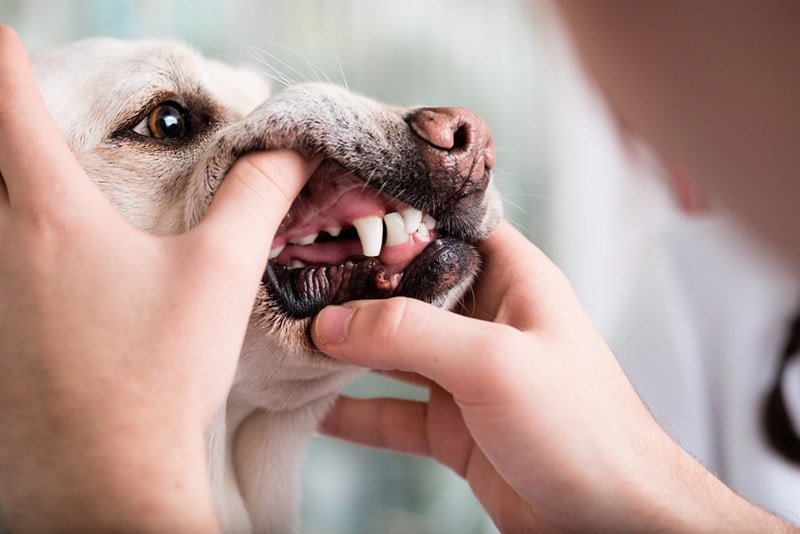How to Tell a Dog’s Age in Human Years: Vet Reviewed Signs & Chart
Updated on

Click to Skip Ahead
You may have heard that 1 dog year equals 7 human years. The idea has been around since the 1950s, and some experts believe that it was just a way for veterinarians to simplify and get dog owners to understand how much faster a dog ages compared to them, in an effort to encourage people to bring in their dogs for checkups more often.
So, how can we tell a dog’s age in human years if that age-old rule is not so cut and dry? We can rely on handy charts and various factors, including breed or visual age indicators, to give us clues when trying to determine a dog’s “human” age. Here’s what you should know about this topic.
What the Research Says
According to the American Kennel Club, the first year of a medium-sized dog’s life is about equal to 15 human years1. The second year of that dog’s life is generally equal to about 9 human years. Afterward, each year of the dog’s life would equal about 5 human years. That said, this is not a fixed rule that can be relied on in all cases. Things like a dog’s breed, size, and health also play a role in a dog’s perceived “human age.”
Researchers in San Diego have developed a more accurate formula for calculating a dog’s age in human years with the help of genetics2. They have done so by mapping molecular changes in the genome. The formula that they’ve created is based on how the patterns of methyl groups change in dogs, humans, and other animals. Therefore, the formula can be used to calculate how old many different animals would be in human years.
However, if you’re like most people, you don’t have the means to test the molecular changes of your dog’s genome, so the latest science currently isn’t that helpful. So, using the American Kennel Club’s guidance is a good way to determine how old your dog is in human years. Include the idea that the larger the dog is, the faster they will age. Try to use the following chart to determine your dog’s “human age.”

Dog Chart in Human Years
| Age of Dog | “Human Age” of Dog, Based on Size | |||
| Small
(20 lbs.) |
Medium
(21–50 lbs.) |
Large
(51–100 lbs.) |
Giant
(100+ lbs.) |
|
| 2 Years | 24 | 24 | 24 | 22 |
| 4 Years | 32 | 32 | 32 | 38 |
| 6 Years | 40 | 42 | 45 | 49 |
| 8 Years | 48 | 51 | 55 | 64 |
| 10 Years | 56 | 60 | 66 | 79 |
| 12 Years | 64 | 69 | 77 | 93 |
| 14 Years | 72 | 78 | 88 | 107 |
| 16 Years | 80 | 87 | 99 | 121 |
What If You Don’t Know Your Dog’s Age to Start With?
You can’t estimate how old your dog is in human years if you don’t know how old they are in dog years. There are a few steps that you can take to figure out how old your pup is, though your estimation will be just that, as it’s not possible to know exactly how old a dog is without knowing when they were born.
Still, you can get an idea of how old they are and provide them with the care that they need accordingly. Here’s what to know.
1. Examining Your Dog’s Teeth

Puppies less than 3–4 weeks old have no teeth at all, and it is easy to tell that they’re newborns, so age determination would be easy at this point. At about 6–8 weeks old, puppies develop a full set of “baby” teeth that are extremely pointed and sharp. The adult teeth will start to grow in around 4–7 months of age and will be larger, rounder, and less sharp.
So, if a pup has a full set of sharp, pointed teeth, they are likely between 2 and 6 months old. If a pup has all their adult teeth, they are likely older than 6 months old.
After this point, it can be tough to tell a dog’s age based on their teeth. Still, it is worth noting that as a dog ages, plaque and yellowing build up on the teeth. So, if your dog has visible plaque buildup, particularly on the back teeth, it’s safe to say that they’re at least a few years old.
2. Checking the Eyes
As a dog ages, so do their eyes. The lenses of a dog’s eyes tend to get cloudy or become discolored in middle age. This is a benign condition called lenticular sclerosis and typically starts to appear between the ages of 6 and 8 years. If your dog has developed this condition, chances are that they’re at least middle-aged.
Lenticular sclerosis should not be confused with cataracts, which is not a benign condition because it can develop into blindness. The eyes of dogs with cataracts continue getting cloudy and can visibly interrupt vision. By contrast, the cloudiness that develops with lenticular sclerosis is typically mild.
3. Working with Your Veterinarian

Your veterinarian may be able to help you determine how old your dog is through a visual inspection and testing. However, keep in mind that even with their expertise, they can’t tell you exactly how old your dog is. They’ll provide you with their best-educated estimate, and you can go from there.
Once you have an idea of how old your dog is in dog years, you can use the chart to estimate how old they are in human years.
Why Does It Matter How Old Your Dog Is?
As a dog ages, their healthcare needs change. Older dogs have different nutritional and exercise requirements to better provide for their changing bodies. Older dogs should also see the vet more frequently to help catch any health conditions as early as possible to ensure proper treatment. Knowing how old your dog is in dog or human years, will help you to take better care of them and help you know how to better prepare for their future.
Conclusion
The truth is that it doesn’t matter how old a dog is in human years. What really matters is their health and happiness throughout their whole life. Still, it can be helpful and interesting to know a dog’s “human age,” if for nothing else than to compare it to your own. It can be fun to watch as your dog surpasses you in human years!
- Related Read: At What Age Do Dogs Go Gray? Vet Approved Advice
Featured Image Credit: cynoclub, Shutterstock















